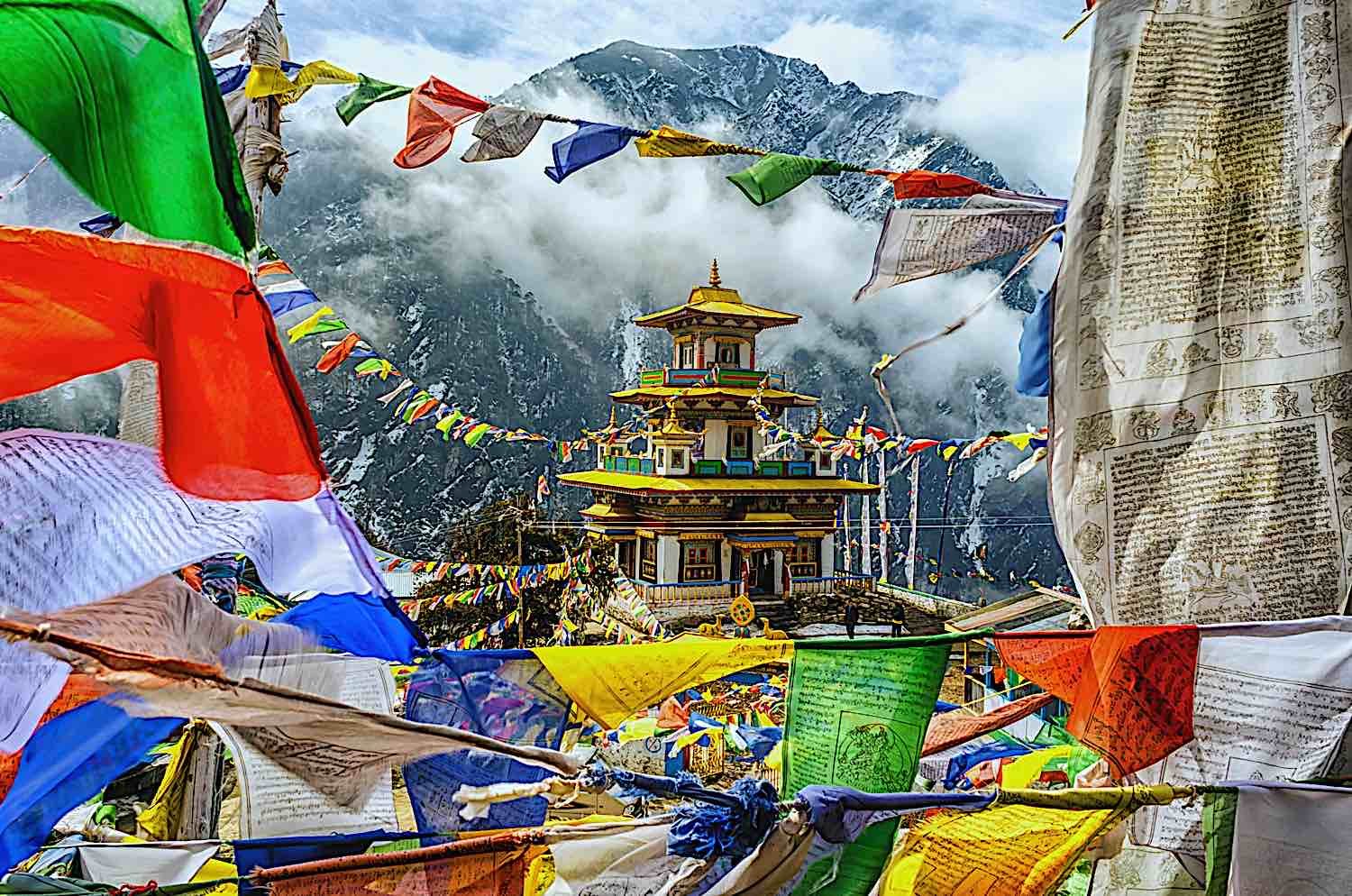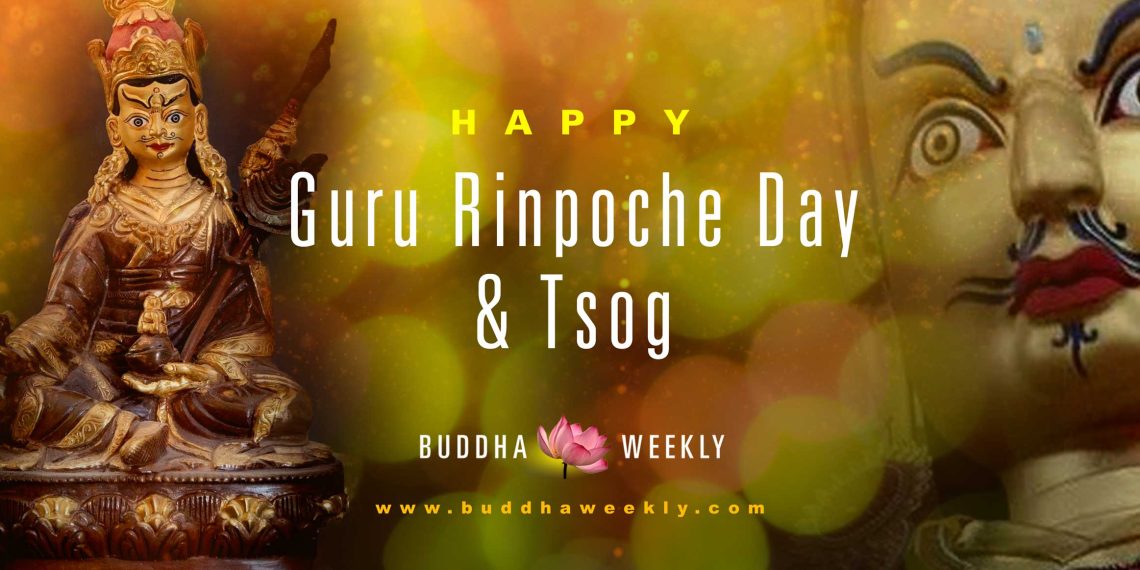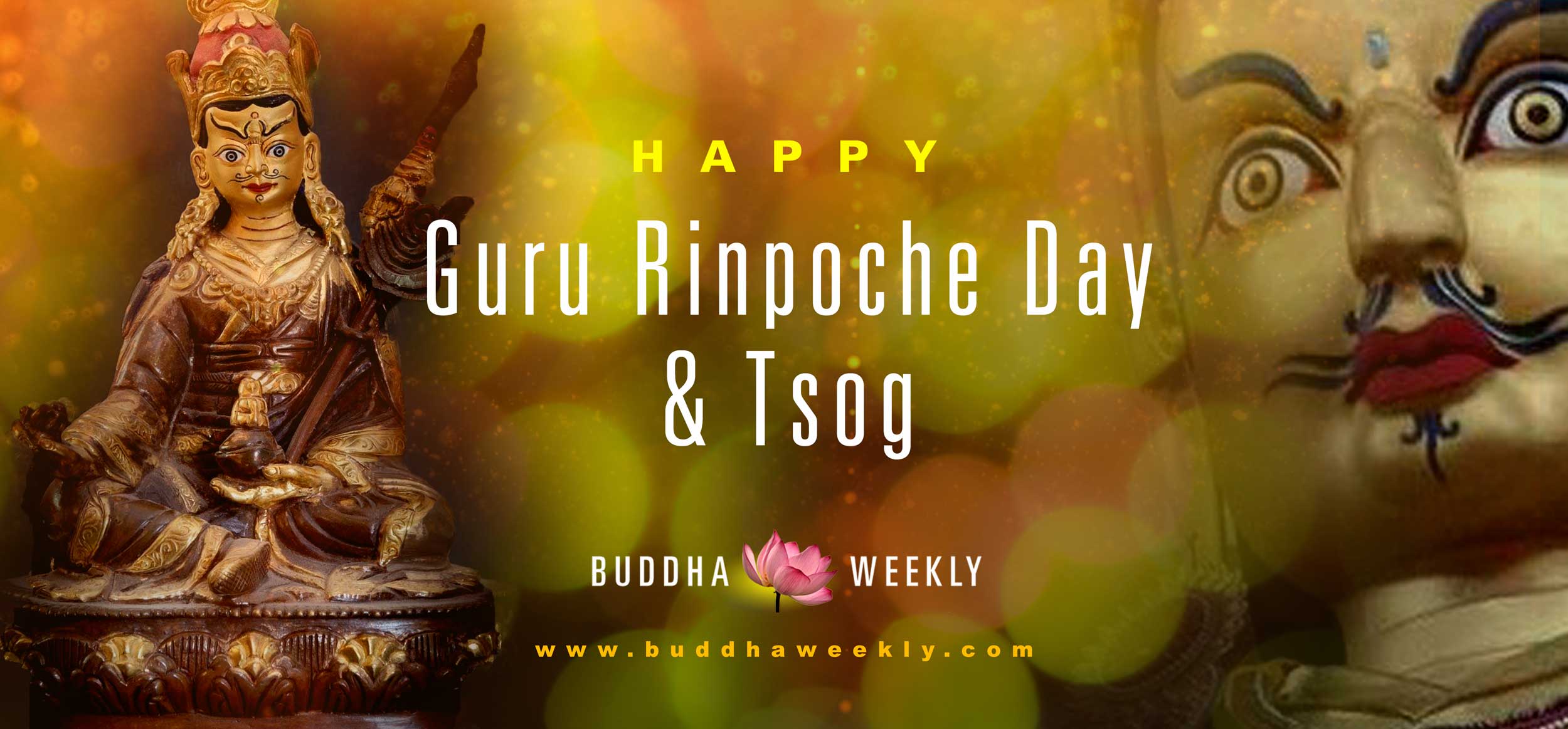
In 2024, June 16th is the Guru Rinpoche anniversary. The Birth Anniversary of Guru Rinpoche is a public holiday in some countries, observed on the tenth day of the fifth and sixth lunar months (most celebrate on the 5th month, which this year is June 16):
“On the 10th day of the fifth and sixth months of the Tibetan Buddhist calendar, we celebrate the birth of Guru Rinpoche, the “Precious Master” and Buddha of our time.” (Samye Institute)
This is a day of extra merit for all Dharma activities and charitable giving or other merit practices, with merit multiplied.

Quick Facts

Practices to Honour the Lotus Born Buddha
Recommended practices, if you are not fortunate enough to be attending one of the organized events, include:
- Guru Rinpoche’s Mantra chanted 1008 times
- Guru Rinpoche’s 7 lines of Praise in Sanskrit, Tibetan or your language
- Offerings to Guru Rinpoche — even if you have no formal altar, you can visualize mental offerings while chanting his mantras.
- Formal pujas
- Formal sadhana practices with Tsog offering (this anniversary day is also the 10th day, which is Tsog offering for those with commitments.)
- Reading Guru Rinpoche’s teachings and life story. (See synopsis below.)

Historical Milestones of Guru Rinpoche’s Life
- Guru Rinpoche, also known as Padmasambhava, which means ‘Lotus Born,’ is a revered figure in Tibetan Buddhism. He is believed to have been born in the 8th century in the region of Oddiyana.
- Padmasambhava’s early life was marked by extensive travels and spiritual training. He studied under various masters, acquiring profound knowledge in both Buddhist and non-Buddhist traditions. His mastery of esoteric practices and tantric teachings set him apart as a unique spiritual figure.
- One of the most significant historical facts about Guru Rinpoche is his pivotal role in the establishment of Buddhism in Tibet. In the 8th century, King Trisong Detsen of Tibet invited Padmasambhava to help overcome obstacles in the construction of the first Buddhist monastery at Samye. Padmasambhava’s arrival in Tibet marked the beginning of the spread of Vajrayana Buddhism in the region.
- Guru Rinpoche is credited with subduing various malevolent spirits and local deities that were obstructing the spread of Buddhism in Tibet. Through his spiritual prowess, he transformed these entities into protectors of the Dharma, thereby facilitating the establishment of Buddhist teachings and practices.
- Padmasambhava’s contributions to Tibetan Buddhism are as vast as the sky, and include the introduction of advanced Vajrayana practices and the establishment of the Nyingma school, the oldest of the four major schools of Tibetan Buddhism. His teachings and practices have had a lasting impact on Tibetan religious culture and continue to be revered to this day.
- Guru Rinpoche is also known for his role in hiding spiritual treasures, or ‘termas,’ which were concealed for future discovery by enlightened beings known as ‘tertons.’ These termas are considered to be teachings and texts meant for future generations, ensuring the continuity and adaptability of the Dharma.
- Historically, Padmasambhava’s influence extended beyond Tibet. He traveled extensively, spreading Buddhist teachings in Bhutan, Nepal, and other Himalayan regions. His legacy includes numerous texts and teachings that continue to be studied and revered by Buddhists worldwide.
- Guru Rinpoche’s life is surrounded by numerous legends and miraculous events. He is said to have had eight manifestations, each representing different aspects of his enlightened activities. These manifestations include Guru Dorje Drolo, Guru Pema Gyalpo, and Guru Shakya Senge, among others.
Chanting the Wish-Fulfilling Mantra of Guru Rinpoche
How is Guru Rinpoche’s Annual Anniverary Celebrated?
- Monasteries and temples across the Himalayan regions, including Tibet, Bhutan, Nepal, and India, hold special prayer sessions and pujas (rituals). Monks and nuns chant sacred texts, recite mantras, and perform elaborate rituals to invoke the blessings of Guru Rinpoche. These ceremonies often include the offering of butter lamps, incense, and flowers.
- Charitable acts and community service are also integral to the celebration of Guru Rinpoche Day. Many Buddhists engage in acts of generosity, such as feeding the hungry, providing aid to the needy, supporting Dharma teachings and helping to Spread the Dharma, and supporting monastic institutions. These acts of compassion and kindness are seen as a way to embody the teachings of Guru Rinpoche and to generate positive karma for oneself and others.
- Devotees engage in personal practices such as meditation, recitation of Guru Rinpoche’s mantras, and reading of his biographies and teachings. One of the most popular mantras chanted on this day is ‘Om Ah Hum Vajra Guru Padma Siddhi Hum,’ which is believed to invoke the enlightened energy of Guru Rinpoche.
- In addition to religious observances, cultural performances such as masked dances (Cham) are held. These dances, performed by monks, depict the life and deeds of Guru Rinpoche and are believed to dispel negative energies and bring blessings to the community.

- Offerings known as ‘tsok’ or ‘tsog’ are prepared and shared among the community. These offerings typically include a variety of foods, such as fruits, sweets, and traditional Tibetan dishes. The tsok ritual is an important aspect of Guru Rinpoche Day, symbolizing generosity and the accumulation of merit.
- Pilgrimages to sacred sites associated with Guru Rinpoche, such as the Taktshang Monastery (Tiger’s Nest) in Bhutan, are common. Devotees undertake these journeys to pay homage, seek blessings, and deepen their spiritual connection with Guru Rinpoche.
- In some regions, elaborate thangka paintings and statues of Guru Rinpoche are displayed and venerated. These sacred images serve as focal points for devotion and meditation, helping practitioners to connect with the enlightened qualities of the Lotus Born.
- Educational activities, such as lectures and teachings by esteemed lamas and scholars, are often organized to provide deeper insights into the life and legacy of Guru Rinpoche. These sessions may cover various aspects of his contributions to Buddhism, including his role in establishing the Vajrayana tradition and his efforts in spreading the Dharma in Tibet. Such educational events help to preserve and propagate the rich spiritual heritage associated with Guru Rinpoche.
Video chanting of the 7-Line praise to Guru Rinpoche in Sanskrit
Buddha Shakyamuni predicted Guru Padmasambhava
Buddha Shakyamuni predicted Padmasambhava’s coming and activities in 19 Sutras and Tantras, stating he would be an emanation of Amitaba and Avaloketishvara.
“Buddha Shakyamuni actually predicted Guru Padmasambhava’s appearance in several different sutras and tantras contain clear predictions of his coming and activities.In the Mahaparinirvana Sutra, Buddha Shakyamuni announced his parinirvana to the students who were with him at the time. Many of them, particularly Ananda, the Buddha’s cousin and personal attendant, were quite upset upon hearing this. So Buddha turned to Ananda and told him not to worry. “…After my parinirvana, a remarkable being with the name Padmasambhava will appear in the center of a lotus and reveal the highest teaching concerning the ultimate state of the true nature, bringing great benefit to all sentient beings.’” [5]
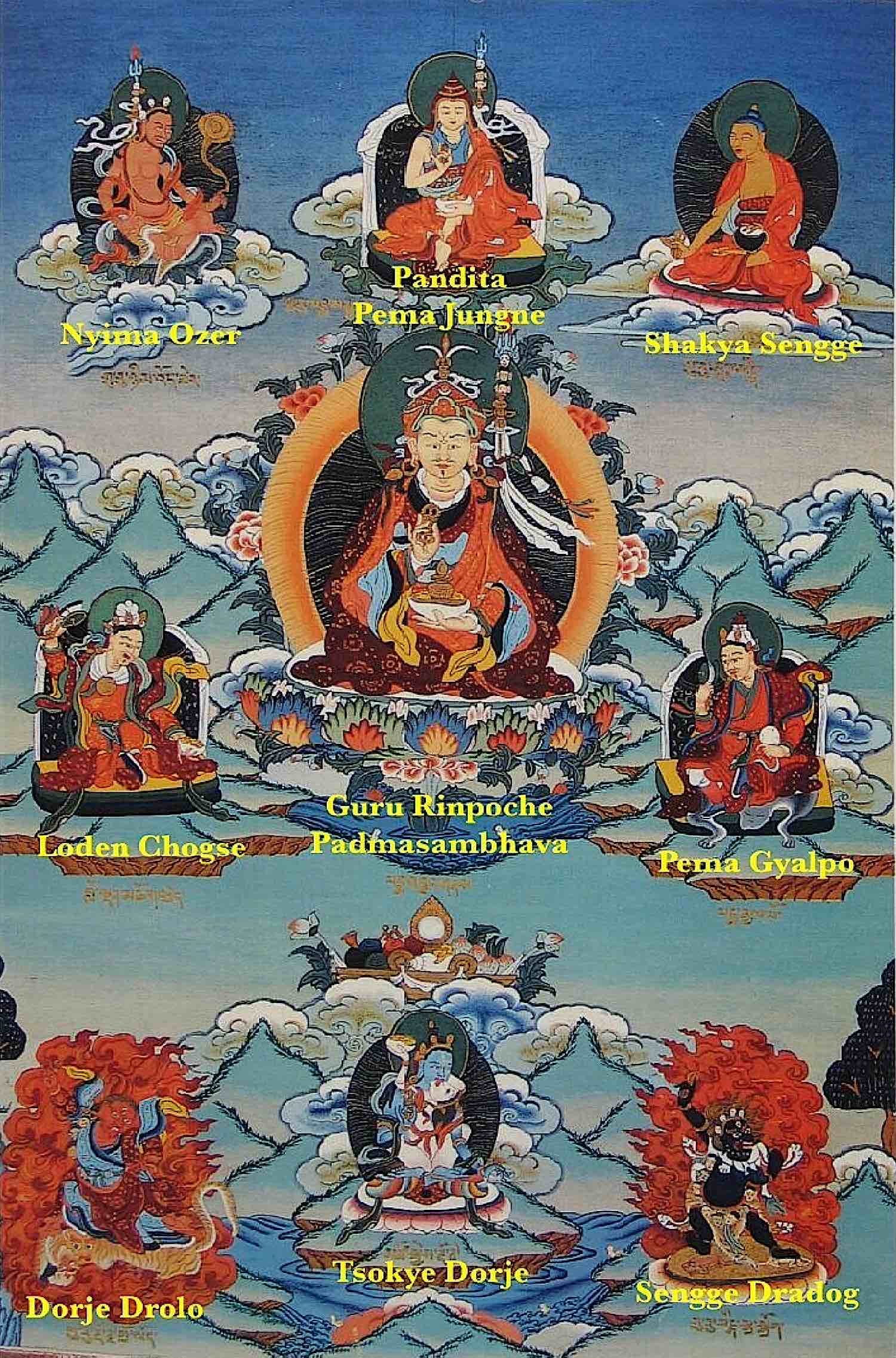
Eight Manifestations of Guru Rinpoche
Padmasambhava’s best known manifestation is probably Padma Gyalpo (Peme Gyalpo), the Lotus King, as described in the Wangdu prayer as the Lotus Lord having “all of samsara and nirvana beneath your control.” [4] However, even his life and manifestations provided lessons in Quantum Mechanics and the “illusory nature” of our relative reality. In the film Guru Padmasambhava – Searching for Lotus born Master – Part I, the filmmaker explores a fascinating concept: that each of the eight key manifestations of Guru Rinpoche represent different energies in Quantum Physics.
About Guru Rinpoche and his Manifestations:
The Lotus Born’s life can be viewed as a perfect exemplar of Quantum Mechanics, or as a life of miracles. He displayed countless miracles and powers, including eight important manifestations at different stages of his wondrous life:
- Guru Tsokyé Dorje, ‘Lake-born Vajra’ (birth)
- Guru Shakya Sengé, ‘Lion of the Shakyas’ (ordination)
- Guru Nyima Özer, ‘Rays of the Sun’ (subjugating demonic spirits)
- Guru Padmasambhava, ‘Lotus-born’ (establishing Buddhism in Tibet); Guru Pema Jungné (Wyl. gu ru pad+ma ‘byung gnas)
- Guru Loden Choksé ‘Wise Seeker of the Sublime’ (mastery of the teachings)
- Guru Pema Gyalpo ‘The Lotus King’ (kingship)
- Guru Sengé Dradrok ‘The Lion’s Roar’ (subjugation of non-buddhists)
- Guru Dorje Drolö ‘Wild Wrathful Vajra’ (concealing terma, binding spirits under oath)
These are not separate Buddhas. Padmasambhava, a fully Enlightened Buddha, could manifest any characteristics suitable to the needs of the world and his followers.
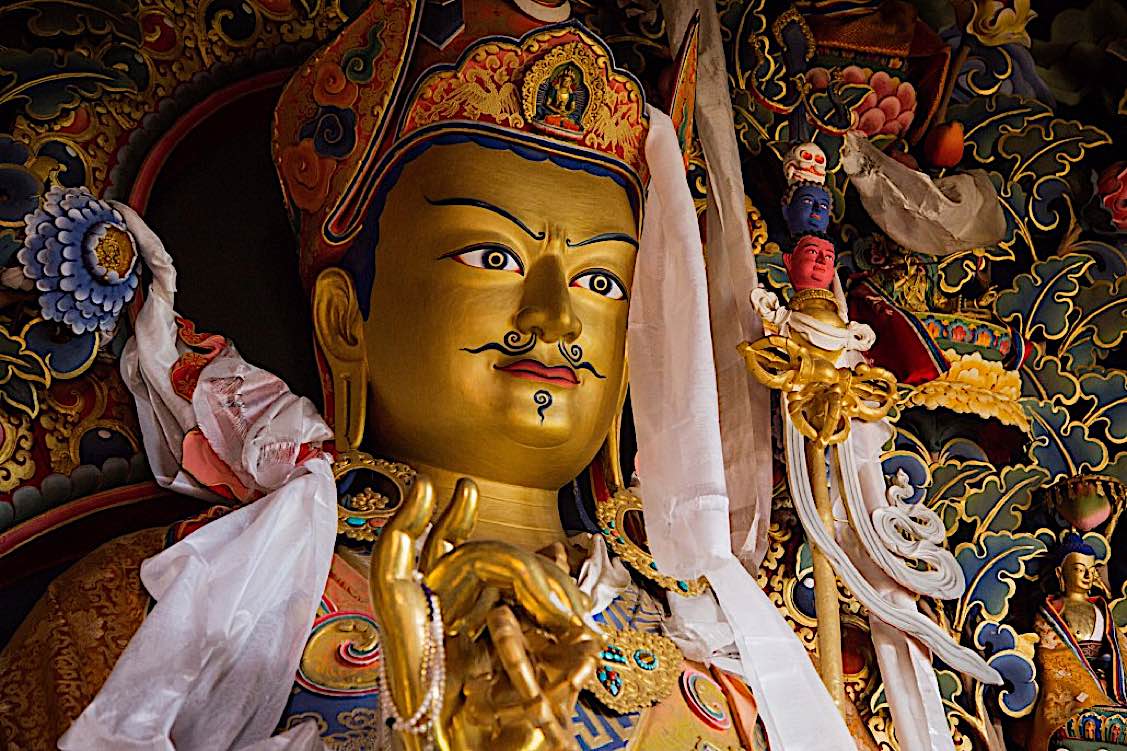
12-Syllable Mantra of Guru Rinpoche
Guru Rinpoche’s mantra is a supreme and profound meditation. It’s benefits are vast, benefiting all beings.
The twelve syllable mantra of Guru Padmasambhava: (in Sanskrit):
oṃ āḥ hūṃ vajra guru padma siddhi hūṃ
Tibetan pronunciation:
om ah hung benza guru péma siddhi hung
Chanting in melody versus for numbers
In a precious teaching, H.E. Garchen Rinpoche explained that most mantras have melodies. In a teaching on the Guru Rinpoche mantra (embedded below), he explained:
“Guru Rinpoche taught about the benefits of chanting the mantra in melody. It is more beneficial to chant the mantra slowly in melody than to recite many mantras quickly. Reciting mantras purely makes a hundred-fold difference. Reciting them in melody makes a hundred-thousand-fold difference. Thus, chanting it in melody multiples the power of mantra.
“And why is its power multiplied? It is because to the extent that you focus on the meaning of each word in the mantra that much greater will be the blessing that enters your mind stream.
“Some people think about the numbers of mantras accumulated and of course, there is benefit from accumulating a number of mantras, but it is said ‘The recitation should be neither too fast nor too slow, neither too strong nor too soft.’ The elements of each syllable should be pronounced without deterioration. Most important for mantra or any other recitation is that the elements of each syllable are pronounced without deterioration.
“This is important. Pronouncing without deterioration has an outer, inner and secret qualities.”
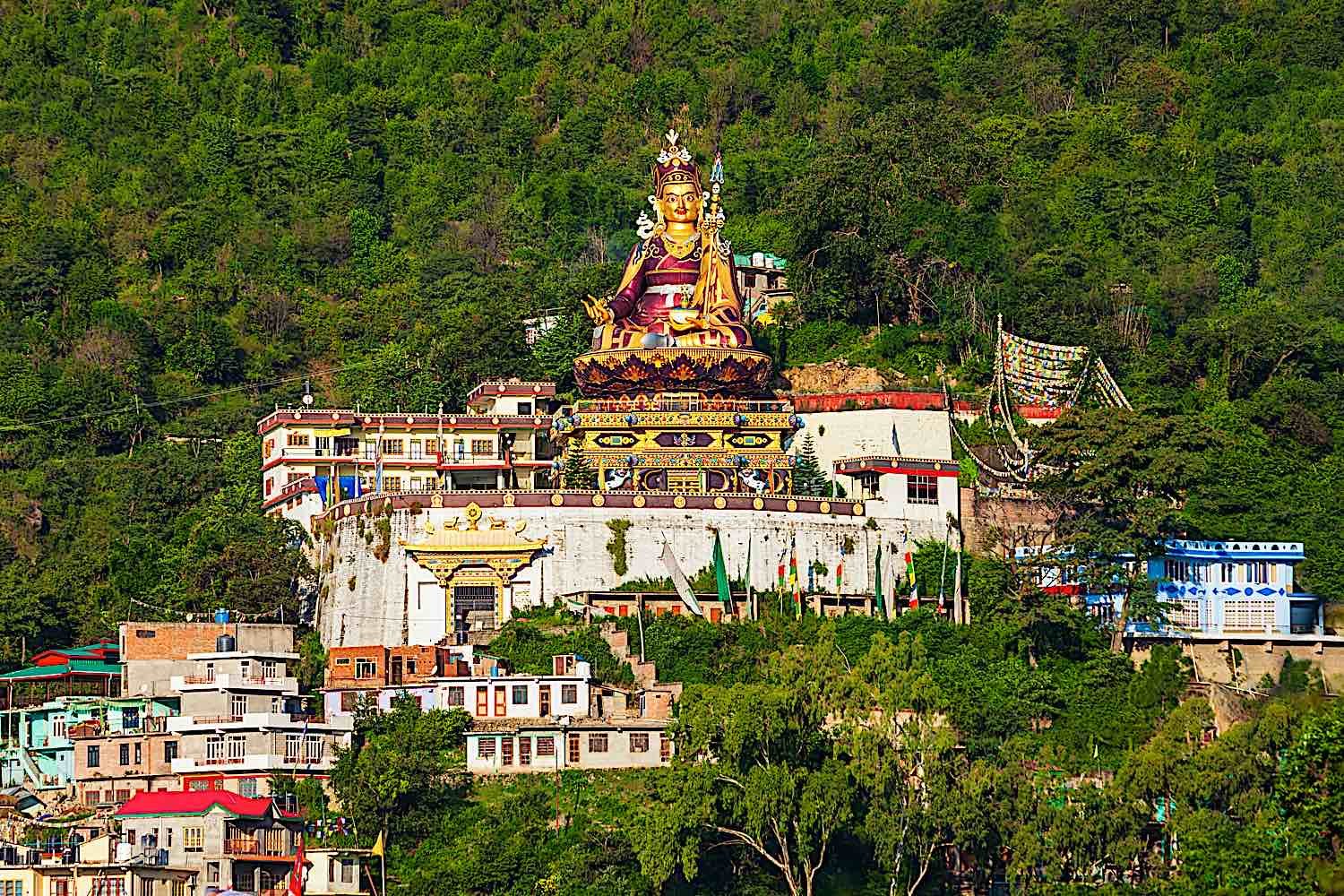
The meaning of the mantra
Guru Rinpoche himself explained his essence mantra to Yeshe Tsogyal [6]:
“O daughter of good family, the Vajra Guru mantra is not just my single essence mantra, it is the very essence or life force of all the deities of the four classes of tantra, of all the nine yanas, and all of the 84,000 collections of dharma teachings. The essence of all of the buddhas of the three times, all of the gurus, yidams, dakas and dakinis, dharma protectors etc., the essence of all of these is contained and is complete within this mantra. How, you may ask, does this work? What is the reason for all these being complete with this mantra? Listen well and hold this in mind. Read it again and again. Write it out for the benefit of sentient beings, and teach it or demonstrate it to beings in the future.”
Garchen Rinpoche’s excellent 34 minute teaching on the Guru Rinpoche mantra:
The essence mantras multiple aspects
The tightest synopsis of the mantra essence meaning as it relates to the five Buddha Families, taken from a teaching by Lama Tarchin Rinpoche: [6]
- OM AH HUM (or HUNG) are the sublime essence of the principles of enlightened body, speech, and mind
- VAJRA or BENZA is the sublime essence of the indestructible family
- GURU is the sublime essence of the jewel family
- PADMA or PEMA is the sublime essence of the lotus family
- SIDDHI is the sublime essence of the activity family
- HUM or HUNG is the sublime essence of the transcendent family.
From the point of view of the aspects or bodies of a Buddha manifestation
- OM is the perfect splendor and richness of sambhoghakaya, the manifest body of splendor
- AH is the total unchanging perfection of dharmakaya, the manifest body of absolute reality
- HUNG perfects the presence of Guru Padmasambhava as the nirmanakaya, the manifest body of emanation
- VAJRA perfects all the heruka deities of the mandalas
- GURU refers to the root and transmission gurus and the holders of intrinsic awareness
- PEMA perfects the assembly of dakas and dakinis
- SIDDHI is the life force of all the wealth deities and the guardians of the treasure teachings
- HUNG is the life force of the dharmapalas, the protective deities.
From the point of view of the three classes of tantra
- OM AH HUNG are the life force of the three classes of tantra
- VAJRA is the life force of monastic discipline and the sutra class of teachings
- GURU is the life force of abhidharma and kriya (action) yoga, the first level of tantra
- PEMA is the life force of the charya (conduct) tantra, the second class of tantra, and yoga (joining) tantra, the third class of tantra
- SIDDHI is the life force of the mahayoga and anuyoga classes of teachings
- HUNG is the life force of the ati yoga, the Natural Great Perfection (Dzogchen)
From the point of view of obscuration’s and poison remedies
- OM AH HUNG purify obscurations arising from the three mental poisons — desire-attachment, aversion, and ignorance
- VAJRA purifies obscurations which stem from anger
- GURU purifies obscurations which stem from pride
- PEMA purifies obscurations which stem from desire and attachment
- SIDDHI purifies obscurations which stem from envy and jealousy
- HUNG in a general way purifies obscurat ions which stem from all emotional afflictions
From the point of view of realizations
- Through OM AH HUNG one attains the three kayas
- Through VAJRA one realizes mirror -like pristine awareness
- Through GURU one realizes the pristine awareness of equalness
- Through PEMA one realizes the pristine awareness of discernment
- Through SIDDHI one realizes the all-accomplishing pristine awareness
- Through HUNG one realizes the pristine awareness of basic space
- Through OM AH HUNG gods, demons and humans are subdued
- Through VAJRA one gains power over the malevolent forces of certain gods and demons
- Through GURU one gains control over the malevolent forces of the Lord of Death and the cannibal demons
- Through PEMA one gains control over the malevolent influences of the water and wind elements Through SIDDHI one gains control over the malevolent influences of non-human forces and spirits bringing harm and exerting negative control over one‘s life
- Through HUNG one gains control of the malevolent influences of planetary configurations and earth spirits
From the point of view of the activities and accomplishments
- OM AH HUNG accomplishes the six spiritual virtues
- VAJRA accomplishes pacifying activity
- GURU accomplishes enriching activity
- PEMA accomplishes magnetizing activity
- SIDDHI accomplishes enlightened activity in general
- HUNG accomplishes wrathful enlightened activity
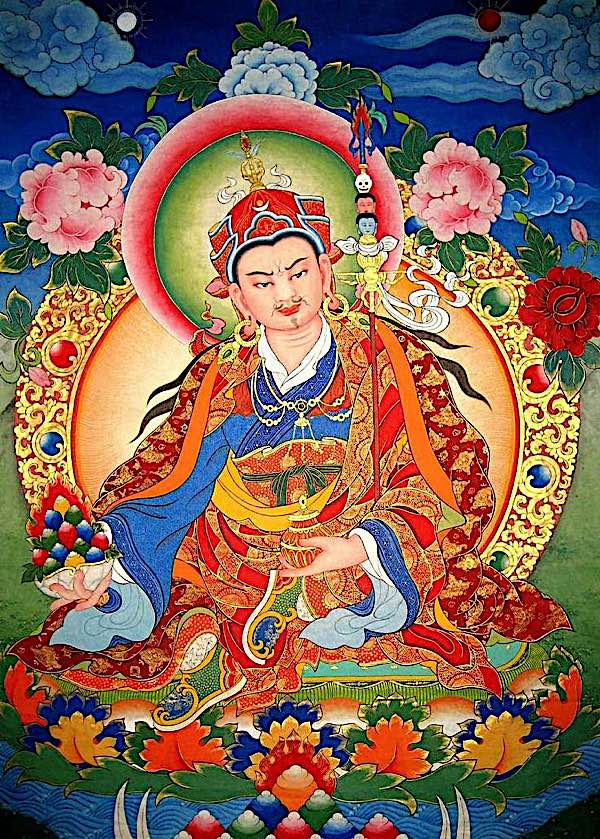
How to recite according to Guru Rinpoche
“One recitation of the Vajra Guru mantra will grant a physical body and entry into this world. Any sentient being who sees, hears, or thinks of the mantra will definitely be established among the ranks of the male and female Awareness Holders. The infallible Vajra Guru mantra is the word of truth; if what you wish for does not happen as I have promised, I, Padma, have deceived sentient beings—absurd! I have not deceived you—it will happen just as I’ve promised.
“If you are unable to recite the mantra, use it to adorn the tops of victory banners and prayer flags; there is no doubt that sentient beings touched by the same wind will be liberated. Otherwise, carve it on hillsides, trees, and stones; after they are consecrated, anyone who merely passes by and sees them will be purified of illness, spirit possession, and obscurations. Spirits and demons dwelling in the area will offer wealth and riches. Write it in gold on pieces of indigo paper and hang them up; demons, obstacle-makers, and evil spirits will be unable to harm you. If you place the mantra upon a corpse immediately upon death and do not remove it, during cremation rainbow colors will flash out and the consciousness will definitely be transferred to the Blissful Realm of Amitābha. The benefits of writing, reading and reciting the Vajra Guru mantra are immeasurable. For the benefit of sentient beings in the future, write this down and conceal it. May it meet with those of fortune and merit. Samaya Gya Gya Gya” [6]
